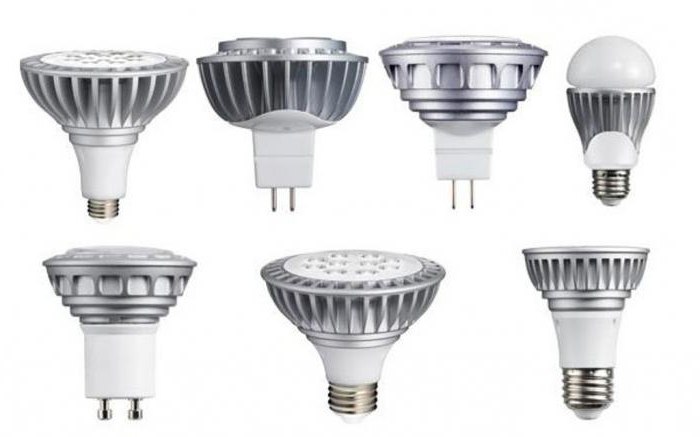The article describes new lighting technologies, or rather LED lamp(LED). Find out what it is. What are the advantages and disadvantages of these lamps. The price of LED lamps, as well as the history of LED lighting
What are LED lamps - LED?
This is an almost ordinary-looking lamp with many LEDs in it, as well as a semiconductor crystal on the substrate and an optical system.
LED or LED is a semiconductor device that distorts electrical voltage into the world. The spectral range of the emitted light depends on the chemical composition of the semiconductor.
The use of Light Emitting Diode (LED) technology in the lighting industry is relatively new. This is primarily because high intensity devices have only become available in recent years. There are two key areas where this technology will impact the lighting industry over the next decade:
- lighting;
- lighting effects.

- Low power consumption compared to conventional lighting. Such a lamp needs 10 watts to illuminate the room is equivalent to a 100 watt incandescent lamp.
- Not ultraviolet radiation. The ultraviolet component of conventional lighting can cause damage to eye tissue.
- The light produces very little heat, reducing the cost of air conditioning construction.
- Lamp life is very long, with most LED manufacturers estimating 40,000-50,000 hours of life. If you use it every day for 5 hours, then the service life will run out in more than 10 years.
- They are environmentally friendly compared to energy-saving lamps containing mercury.
- Light weight, impact resistant.
- Instant warm-up, less than 1 sec.
Disadvantages of LED lamps - LED, reviews
- The main and significant disadvantage of these lamps is their price, it is much more expensive than both incandescent and energy-saving lamps. See prices below.
- Some complain that LED lamps have an unpleasant glow spectrum. Therefore, they can be used in lamps for reading books or other painstaking work unacceptably. But you also need to take into account the fact that many people probably bought and used old versions of such lamps. Now technologies are progressing every year and the light of new led lamps is becoming more and more qualitative than before. Buy one of these good lamp in a specialist shop and see for yourself that this is the right solution.
- Because of the massive use economical lamps energy companies and the state suffer, after all, it is their profit that is being saved. That's why they often raise their electricity bills. But I do not think that this is a reason to abandon such lamps. Now they are simple, incandescent lamps have to be replaced every 2-4 months, as they often “fly out” due to poor-quality production. And the counter is wound up 5-8 times more.
Prices for LED lamps
In Russia, the Tegas Electric company is actively engaged in the production of LED lamps and other components for them. Now Available wide choose products, whether it is lamps in light fixtures for not big room or in a plafond for a huge office space. As well as technical lamps for street lighting.
Prices for such lamps starts from 200 rubles to 1000 or more. The price depends on specifications lamps. Over time, the prices of this product will decrease. LED lamps will become more affordable for the population.
![]()
Lighting in general requires the use of white light. LEDs cannot produce White light, they can only produce certain color spectrum. An LED is a semiconductor device that is made from a combination of chemically polarized semiconductors. Chemical composition, chosen to determine the energy of electrons that pass through the interface between two types of semiconductors. This energy is converted into light as a stream of electrons, although the device is determined by the wavelength of the resulting colored light.
There are two possible approaches for LED light production. The first one was first used in Japan in 1996: A blue LED is coated with white phosphor. When the blue light hits inner surface phosphor, it emits white light. This technology is currently being considered commercially, but there are still some concerns about life cycle technologies. It has been noted that phosphorus can reduce luminous flux during the year. The current life estimate is about 6 years.
The second way to produce white light is to use additive mixing of the three primary colors: red, green, and blue.
The concept of blending the light output of LEDs was first realized in 1979 by the workers at Sound Chamber. The product called "Saturn" involves a rotating propeller. Each of the three propeller wings was built from boards equipped with red, green and yellow LEDs. (The blue LED has not yet been invented.)
Each of the LEDs is controlled by the width pulse modulation(PWM), which allows you to keep the intensity of each individual LED under control. The product can generate a huge number of colors.
The next technological leap came in 1993, with the invention of the blue LED.
In early 1994, an artistic licensed prototype of what is believed to be the first complete color mixing using red, green and blue LEDs was invented. The design used pulse modulation of each color channel, with a Zilog Z8 microprocessor.

In Belgium, LUMILED, a joint venture between Philips and Agilent, is developing into ultra-high brightness LEDs. In Japan, Nichia continues to insist on brightness-value ratio. In England, Cambridge Display Technology succeeded in creating the world's first blue light-emitting polymer (LEP) and has now moved on to white organic light-emitting diodes (OLED). Currently, all developments in this area are aimed at producing technologies that can be used in color display screens.
In the US, the Massachusetts Institute of Technology (Nano Structures Lab) is working on a device called the photonic bandgap LED. Initially research aimed at improving the efficiency of single color LEDs. Extensions to this research could lead to an LED where both color and intensity can be set electronically. The potential for lighting effects is simply amazing. The most notable of which is the ability to produce more high resolution control over the low intensity range. This is of particular interest in mixing colors.
They have many advantages over other types of lighting fixtures. They consume much less electricity and can also last up to 20 years even with regular operation. Today, there are a huge number of manufacturers who focus their production on this type of product. Due to this variety, LED lamps have a lot of properties that determine their quality and durability.
Every owner should find out before going to the store. Knowing what parameters of the device to pay attention to, as well as which manufacturers have gained a reputation for reliability, this will not be difficult.
General characteristics
The LED lamp is a complex high-tech device that has a number of characteristics. These include the angle of dispersion and the strength of the flow of rays, the type of base, power, and also the manufacturer. So, choose the best LED lamps for the home.
The design of the presented illuminators may be different. Most often, lamps with a bulb or "corn" are used for the home. Depending on the technical characteristics of the devices, they can be installed both to illuminate the entire room, and to create spot lighting. This allows designers to implement various decorative effects with the presented devices.
Advantages of LED lamps
Considering, it is necessary to say a few words about their advantages. If we compare these devices with luminescent varieties, several main qualities immediately stand out. LED lamps are much safer, do not contain poisonous gases inside the bulb, and are also more economical and more durable. They are resistant to voltage drops and turn on instantly. Therefore, LED lamps are replacing fluorescent housekeepers from the market. 
LEDs are today considered the most economical type lighting. Incandescent lamps are also inferior to these devices in many respects. First of all, it concerns energy consumption. In LED varieties, it is many times less. Also, thanks to the low-temperature operation and design features new lighting have a long service life - about 20-30 thousand hours. Incandescent lamps last about 1,000 hours.
Power
One of the important indicators that LED lamps have is their power. It characterizes how much electricity the device will consume during operation. Incandescent lamps had a direct relationship between power indicators and the strength of the luminous flux. But in LED instances, power consumption does not directly affect the brightness of the glow. This indicator depends on the manufacturer and the technology that he uses to create his products. 
Light flow usually measured in lumens. He is the one who answers the question how to choose led lamp. Electrician's advice will help you choose the device approximately according to its power. When compared with incandescent lamps, LED specimens consume approximately 5 times less energy. Therefore, if you want to create lighting of the same brightness as the old-style 75 W illuminator, you need to purchase new device power of 15 watts.
glow temperature
To indicate the shade of the LED lamp, manufacturers use such an indicator as the glow temperature. White color may be warm or cold. The diode temperature is measured in Kelvin. The less her digital value, the warmer the shade of the appliance. Studying the question how to choose led lamps for home, attention must be paid to this indicator. 
The usual incandescent lamp, for example, is characterized by a glow temperature of 2500-3000 K. LEDs can also have such a glow temperature. However, they are chosen more out of habit. Much more pleasing to the eye evening time average Colorful temperature. This is natural white light, as close as possible to daylight.
There are many for sale LED fixtures with a glow temperature of 5500-6500 K. However, it is better to install such products in office space. In the apartment they are uncomfortable.
plinth
When choosing an LED lamp, it is imperative to pay attention to the type of base. It is required to purchase a device of the same type that was previously installed in a chandelier or lamp.
The most common used to be socles E27 and E14. The first option was used for ordinary chandeliers, and the second - table lamps. Today, such plinths are also common. Therefore, manufacturers of LED lamps produce devices with the same type of design. They are almost always designed for connection to a 220 V network.
Today, spot lighting is common, consisting of several small light bulbs. They have a base marked G. Most often, devices of the type G4, G13, GU5.3 are produced. This indicator is also taken into account when deciding whether how to choose led lamp. 
G4 for the home is considered one of the the best options. This type of base is suitable for installation in a 12 V network. Small light bulbs with a G base are most often used in wet rooms.
Radiator
studying, How to choose the right LED bulb for your home, you need to consider such an important factor as the heat removal system. During operation of the device, this function is performed by a radiator. Quality product distinguished by the presence of this structural element made of aluminium.
Cheap, low-quality devices can be made without a radiator at all. The life of such a product will be very limited. There are also LED lamps in which plastic is used instead of aluminum to remove heat. This indicates an insufficient efficiency of the cooling system. If you want to purchase a device that will serve for the benefit of its owners for years, you need to purchase high-quality lamps with an aluminum radiator.
If the flask is made of matte material, it is not possible to evaluate the internal structure of the device. Therefore, when purchasing a lamp from an unverified manufacturer, it is better to put such products aside.
Lifetime
studying, how to choose led lamp for home, the property owner is interested service life this appliance. The manufacturer may state that the device is guaranteed to work from 20 to 50 thousand hours. However, there are several nuances here.
Devices of quality manufacturers can really function up to 20 years. The service life of the device directly depends on the quality of its components and assembly. However, even the highest quality LEDs decrease in brightness over time, their degradation is observed.
Cheap devices from little-known manufacturers can fail during the first months of operation. Therefore, for long-term operation light bulbs are better to give preference to well-known brands. They give a guarantee on their products from 3 to 5 years. During this period, breakdowns of LED lamps are practically not observed.
Scattering angle
The angle of dispersion is also important in deciding whether What are the best LED bulbs for your home? Select a quality device will allow inspection of the flask of the device. In order for the light flux to illuminate the room with high quality, the bulb must have a diverging lens. It also plays an important role in the presence internal coating from phosphor. This depends on the nature of the lighting. 
If the diodes inside the bulb are located in the same plane, the light flux will be narrowly directed. Such devices are suitable for spot lighting. For a large room, it is better to choose lamps with multi-level placement diodes. Lighting in this case will be diffused, soft.
The light transmission coefficient is also worth considering when choosing a device. If you want to create full-fledged bright lighting in the room, you need to purchase devices with an indicator of at least 80. Their bulb is most often transparent. Matte specimens with the same power consumption do not create such a strong luminous flux.
Product packaging
The packaging can say a lot about the quality of the appliances inside. This is worth paying attention to, wanting to purchase durable and reliable led lamps for home. How to choose (reviews experts and ordinary users will help in resolving this issue) the best specimens need to be considered in more detail.
From trusted manufacturers, the packaging provides the buyer with information about the set of characteristics of the LED lamp. If there are not several items on it, it is better not to purchase this device.
Popular, trusted manufacturers on the packaging must indicate information about the power, type of base, luminous flux and the light transmission coefficient of the device. The color temperature in Kelvin and the lamp warranty period are also indicated. The packaging must contain basic data on the location of the manufacturer, contact information. A barcode is required.
Manufacturer's choice
Today, many companies around the world manufacture various led lamps for home. How to choose a manufacturer? The advice of experienced experts will help. The domestic consumer is presented today with devices both foreign and own production. There are a lot of companies that make high-quality LED lamps. 
Among foreign brands, market leaders are such companies as CREE, Philips, Osram, Nichia, etc. These are corporations that were among the first to manufacture such products. The quality of their lamps is really high, but their price is also high.
Of the relatively inexpensive foreign companies, the Chinese brand Maxus should be noted separately. Their quality is quite high. Guarantee period it is also quite long.
Domestic manufacturers offer the consumer high-quality products at a low cost. The best brands are Optogan and Svetlana-Optoelectronics.
Electricity has been used to illuminate rooms for a very long time. For a long time, only incandescent bulbs were used in apartments, offices, shops, houses, etc. These small devices are still valued mainly for a rather powerful stream of light, which, in addition, has a natural shade that is pleasant to the eye. However, incandescent bulbs have several significant drawbacks. First of all, these are high rates in terms of electricity consumption and a short service life. Therefore, in Lately other types of lighting devices are becoming more and more popular - economical and durable. The latter include those invented not so long ago LED lamps.
A bit of history
The LED was first made by renowned engineer Nick Holonyak in 1962. The device he designed emitted visible red light. Shortly after the appearance of this interesting invention, the American company Monsanto put its production on stream. The first device of this type rolled off the assembly line in 1968. Monsanto's light bulbs were intended for use primarily in digital watches and calculators. For the next few decades, LEDs were used only in industrial and consumer electronics.
LED lamps 220V emitting bright white light and designed for indoor lighting for various purposes, began to be produced only in 1997. The creator of the first such device was the American Fred Schubert. Nowadays, such devices are already used in many industrial and residential premises.
Basic structural elements
Modern LED LED lamps are assembled using the following components:
The most popular manufacturers
Brands of devices of this type on the modern Russian market there are many. Which manufacturer should be preferred when choosing a device such as an LED lamp? Device Reviews of this type generally positive. However, according to buyers, products of European brands have the greatest reliability. Chinese lighting fixtures, as already mentioned, can not always boast of quality. The same should be said about the products of domestic manufacturers.
Of the European brands, the most popular, judging by the reviews, are Artpole, ASD and Navigator LED lamps. The most expensive at the same time are the products of the Artpole company. ASD and Navigator are cheaper, but give somewhat dimmer light output. Quite strongly, the lamps of these manufacturers differ in design. But in this case, the choice, of course, will depend on the personal taste preferences of the buyer.

Thus, the main advantages of LED lamps include, first of all, efficiency and long term services. Their undoubted advantage is also ecological cleanliness. And which LED bulbs are best for home or office? According to consumers, it is better to purchase models from a well-known manufacturer. The high cost will justify - due to efficiency - only a high-quality device. A cheap Chinese light bulb is likely to fail very quickly.




